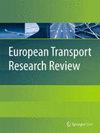高级驾驶辅助系统(ADAS)对道路安全的影响分析--计算减少的潜力
IF 4.2
3区 工程技术
Q1 TRANSPORTATION
引用次数: 0
摘要
本研究对某些高级驾驶辅助系统(ADAS)进行了道路安全影响分析。根据文献综述、专家访谈和当前的立法调整,选出了最有前途的九种 ADAS。根据奥地利的车祸统计数据对其影响进行了分析。考虑了基础设施和天气条件、市场渗透率、传感器的预期功能、用户接受度和风险平衡等因素。我们开发了一个软件工具,用于计算在 2025、2030 和 2040 年的情况下,所选 ADAS 减少碰撞事故的潜力。结果表明,与警告/制动相关的 ADAS 在未来具有最大的减少碰撞事故的潜力,到 2040 年可在奥地利减少多达 8700 起碰撞事故和 70 起死亡事故。此外,与奥地利目前的车祸数量相比,智能车速辅助系统将在 2040 年使车祸总数减少 8%。重型载货汽车的转弯辅助系统所减少的碰撞事故和伤亡人数最少,但由于每次碰撞事故的严重程度最高(每 1,000 次碰撞事故中有 93 人死亡),该系统对减少道路交通死亡人数做出了重要贡献。然而,要从 ADAS 的安全潜力中获益,正确使用这些系统至关重要。今后,有必要向用户提供更多关于正确使用、各 ADAS 系统的优点和局限性的信息,并将这些系统的使用纳入驾驶员教育程序和测试中。本文章由计算机程序翻译,如有差异,请以英文原文为准。
Impact analysis of Advanced Driver Assistance Systems (ADAS) regarding road safety – computing reduction potentials
In the present study road safety impact analysis for certain advanced driver assistance systems (ADAS) was conducted. Based on a literature review, expert interviews and current adaptations in legislation, the most promising nine ADAS were selected. The impact was analysed based on statistical crash data from Austria. Factors such as infrastructure and weather conditions, market penetration, expected functionality of sensors, user acceptance and risk homeostasis were considered. A software tool was developed to calculate the crash reduction potential of the selected ADAS for the scenarios 2025, 2030 and 2040. The results show that the ADAS related to warning/braking have the greatest future reduction potential and could lead to a reduction of up to 8,700 crashes and 70 fatalities in Austria in 2040. In addition, the Intelligent Speed Assistance system would lead to an overall crash reduction of 8% compared to current crash numbers in Austria in 2040. The Turning Assistant for heavy goods vehicles shows the lowest reduction in crashes and casualties, but due to the highest severity per crash (93 fatalities per 1,000 crashes), it nevertheless provides an important contribution to the reduction of fatalities in road traffic. However, to benefit from the ADAS safety potential, it is highly relevant that these systems are used in a correct manner. In the future, it will be necessary to provide users with more information on the correct use, benefits and limitations of the respective ADAS and to integrate the use of these systems into driver education procedures and tests.
求助全文
通过发布文献求助,成功后即可免费获取论文全文。
去求助
来源期刊

European Transport Research Review
Engineering-Mechanical Engineering
CiteScore
8.60
自引率
4.70%
发文量
49
审稿时长
13 weeks
期刊介绍:
European Transport Research Review (ETRR) is a peer-reviewed open access journal publishing original high-quality scholarly research and developments in areas related to transportation science, technologies, policy and practice. Established in 2008 by the European Conference of Transport Research Institutes (ECTRI), the Journal provides researchers and practitioners around the world with an authoritative forum for the dissemination and critical discussion of new ideas and methodologies that originate in, or are of special interest to, the European transport research community. The journal is unique in its field, as it covers all modes of transport and addresses both the engineering and the social science perspective, offering a truly multidisciplinary platform for researchers, practitioners, engineers and policymakers. ETRR is aimed at a readership including researchers, practitioners in the design and operation of transportation systems, and policymakers at the international, national, regional and local levels.
 求助内容:
求助内容: 应助结果提醒方式:
应助结果提醒方式:


